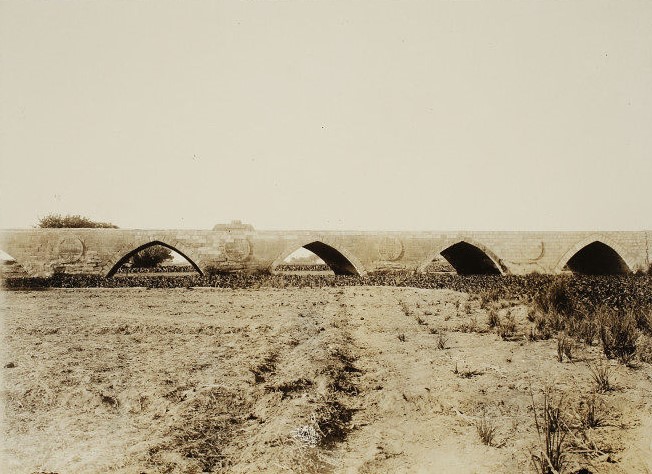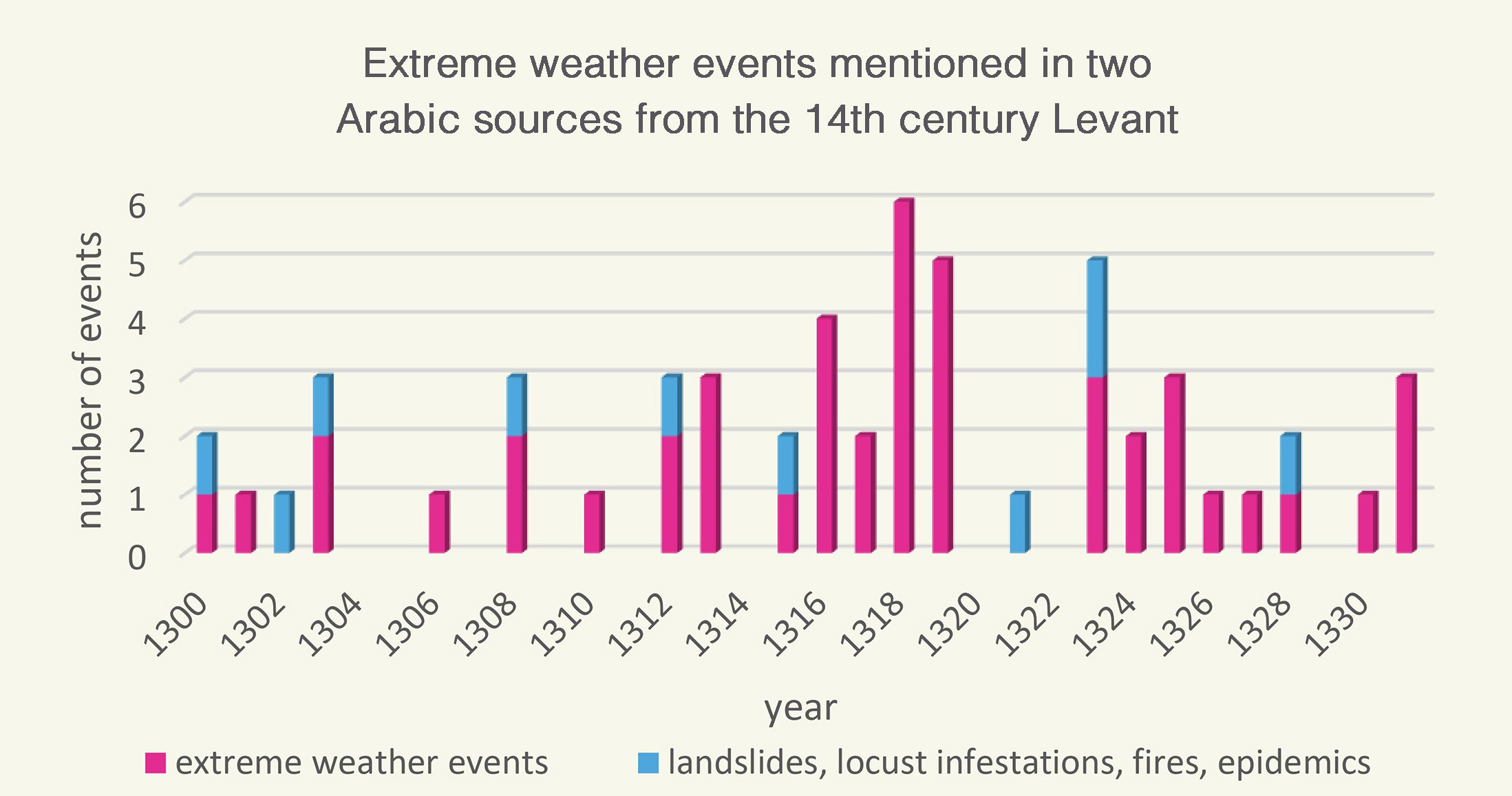- Home
- Publications
- PAGES Magazine
- The Potential of Written Sources For a Historical Climatology of The Middle East During The Mamluk Era
The potential of written sources for a historical climatology of the Middle East during the Mamluk era
Ott U
Past Global Changes Magazine
28(2)
56-57
2020
Undine Ott
The Mamluk era (1250–1517 CE) was a period with phases of climate instability in the eastern Mediterranean. A trove of written sources has survived from this period but still awaits evaluation for climate history reconstruction in the Middle East.
The climate of the Middle East is more varied than the stereotypical image of barren deserts might suggest. The region encompasses Mediterranean-climate, semi-arid, and arid zones. Winter tends to bring more precipitation, while summers tend to be dry. During the medieval period, agriculture constituted by far the most important economic sector. Regardless of whether farmers practiced techniques of dry farming or relied on irrigation, agriculture depended largely on winter rains, and fluctuations in precipitation during this season could heavily affect the year's production (Frenkel 2014; Kaniewski et al. 2012).
A plethora of sources
A large number of written sources have been preserved from the Mamluk Sultanate that existed in Egypt and the Levant. The bulk of the sources is in Arabic. Arabic chronicles and annals are particularly informative about weather events and climate conditions. These works far outnumber what is extant from this period from most other parts of the world, including Europe. Mamluk-era diaries, travelogs, poems, biographies of rulers, encyclopedias, and anthologies occasionally provide useful information for historical climatology as well (Tucker 1999).
 |
|
Figure 1: Bridge over the former Abū l-Munajja Canal which regulated the irrigation of the eastern Nile Delta, Cairo, 1260s. (Photo: K. A. C. Creswell, 1916–21, © Victoria and Albert Museum, London.) |
The majority of the Mamluk-era material falls into the genre of narrative sources. Documentary sources such as charters, letters, registers, or protocols, by contrast, are rare (Hirschler 2016). Furthermore, they hardly ever contain information on weather and climate. The same applies to inscriptions on buildings, tombstones, or objects. As a result, serial data on temperatures or harvest dates, for instance, cannot be compiled for medieval Egypt and the Levant.
The surviving narrative sources provide eyewitness accounts or, at least, contemporary testimony to the climate history of the Middle East. The authors were scholars or high dignitaries of the Mamluk Sultanate and focused on the urban centers and their surroundings. Rural areas are less well covered. The works generally report extreme weather events; only rarely do they remark upon normal weather conditions. The annual Nile flood is an exception: given its crucial importance for agriculture in Egypt, the flood was monitored by the sultan's court in Cairo. Cairo's canals were opened the day the river reached the level deemed sufficient to inundate the farmland of the city and its surroundings (Fig. 1). Both the elite class of the sultanate and the general population celebrated this day (in Arabic: Wafā al-Nīl), the date of which varied from year to year. As an event, it is regularly mentioned in the aforementioned written sources even for years with average Nile floods (Hassan 2007).
The Mamluk-era chronicles and annals provide information related to precipitation, temperature, and volcanic activity. They report on hail and sandstorms as well as floods and landslides, periods of severe cold, snowfall, low river levels, droughts, and eruptions of volcanic fields. Other disastrous events like earthquakes, tsunamis, city fires, epidemics, famines, or locust infestations are mentioned as well. The main extensive body of evidence concerns precipitation; water was a crucial resource in the Middle East, and too little rainfall could have severe consequences. The same was true for too much precipitation: torrential rains could overstrain canals and wash away streets. The economic and social infrastructure of rural, urban, and nomadic communities was highly vulnerable to precipitation anomalies.
Current state of research
The historical climatology of the medieval Middle East is still in its infancy. Ronnie Ellenblum (2012) attempted to reconstruct the climate history of the pre-Mamluk Middle East from written sources, and detected a series of climate disasters in the 10th and 11th centuries — the era that has been termed, with regard to Europe, the "Medieval Climate Optimum". Kate Raphael (2013) studied droughts, famines, earthquakes, and infestations of locusts, mice, and rats which affected the Middle East between the 12th and 14th centuries. Kristine Chalyan-Daffner (2013) analyzed reports from Mamluk-era sources of disastrous floods, droughts, and earthquakes in Egypt.
Recently, a group of geographers from the University of Freiburg created a dataset based on weather reports in written sources that the Middle East historian Heinz Grotzfeld had collected in the 1980s and 1990s. They published the list of entries accompanied by metadata (Vogt et al. 2016) and also entered the reports into the Tambora online database (www.tambora.org). This constituted the first attempt to systematically collect information on the climate history of the Middle East. Unfortunately, it often cites scholarly editions of sources incorrectly, and the paraphrases given of reports in Arabic sources do not, in all cases, seem reliable (see for example Glaser et al. 2016, p. 7, which provides an imprecise and incomplete translation of a passage from an Arabic source). Furthermore, a number of the editions of sources Grotzfeld had used have been surpassed by newer, improved editions. Besides, the dataset created fails to take into account a large number of extant Arabic sources.
 |
|
Figure 2: Extreme weather events and disasters mentioned in Abū l-Fidāʾ's al-Mukhtaṣar (completed ca. 1330) and Ibn Kathīr's al-Bidāya wa-l-nihāya (ca. 1370) for the period 1300–1331 CE. |
Potential pathways of future research
Apart from the Grotzfeld dataset, there is, to date, no systematic collection of Middle Eastern historical material for any period between 500 and 1500 CE despite the unique abundance of sources. Instead, studies like Raphael (2013) have, in part, relied on single anecdotes found in the extant sources, or have utilized works written centuries after weather events had supposedly occurred. More source-critical studies are needed to assess the potentials as well as the pitfalls of working with the extant Arabic material.
A systematic collection of information on medieval weather events would help to illuminate medium to long-term developments in the climate history of the Middle East. A searchable online database would enable comparative studies and greatly facilitate interdisciplinary cooperation. The use of digital tools might generate new questions and propose new answers. In order to present climate-related information from written sources in a meaningful way, ordinal-scale indices for precipitation or temperature have proved useful with regard to other regions of the globe (Nash et al. in review). Indices help to quantify information from narrative sources, but no index tables have been thus far compiled for past Middle Eastern climate conditions.
Besides medium and long-term developments, single cases of extreme weather events and natural disasters might be studied (Schenk 2017). Our understanding of Mamluk politics, society and economy has significantly improved in recent years. The growing scholarship provides an ideal base for case studies on the human response to climate instability: how were disasters and climate change perceived in Mamluk-era Egypt and the Levant, how were they managed, and what impact did they have on society?
The pioneering book by Ellenblum (2012) on the climate history of the Middle East does not incorporate much data from natural archives (Preiser-Kappeler 2015), though recent studies of speleothem archives, tree-ring data, pollen records, corals, and lake sediments have provided new insights into medieval climate conditions in the eastern Mediterranean. Historical climatology needs to incorporate these findings (Telelis 2008). The Mamluk era covers the phase of transition from the Medieval Climate Anomaly to the Little Ice Age. The written record at times provides more detailed and more precisely dated information than paleoclimatic data. A first preliminary survey of weather-related reports in Arabic annalistic works suggests, for instance, that the 1310s witnessed an extraordinary series of extreme weather events (Fig. 2). This period has, with regard to Europe, been termed the "Dantean Anomaly" (Brown 2001, pp. 251-254). The Freigeist Dantean Anomaly Project (dantean.hypotheses.org), hosted by the Leibniz Institute for the History and Culture of Eastern Europe in Leipzig, aims to compare medieval climate conditions in the Middle East and several regions of Europe. Comparative projects like this might contribute to answering the question whether phases of climate instability during the Middle Ages were limited to certain regions or constituted rather global phenomena (Bauch et al. 2020; Roberts et al. 2012).
affiliation
Leibniz Institute for the History and Culture of Eastern Europe, Leipzig, Germany
contact
Undine Ott: undine.ott leibniz-gwzo.de
leibniz-gwzo.de
references
Bauch M et al. (2020) Clim Past Discuss, doi:10.5194/cp-2020-34
Brown N (2001) History and Climate Change: A Eurocentric perspective. Routledge, 391 pp
Frenkel Y (2014) Hist Compass 12: 866-878
Hassan FA (2007) Quat Int 173-174: 101-112
Hirschler K (2016) J Am Orient Soc 136: 1-28
Kaniewski D et al. (2012) Proc Natl Acad Sci USA 109: 3862-3867
Nash DJ et al. (2020) Clim Past Discuss, doi:10.5194/cp-2020-126
Preiser-Kappeler J (2015) Jahrbuch der Österreich Byzantinistik 65: 195-242
Roberts N et al. (2012) Global Planet Change 84-85: 23-34
Telelis IG (2008) Jahrbuch der Österreich Byzantinistik 58: 167-207
